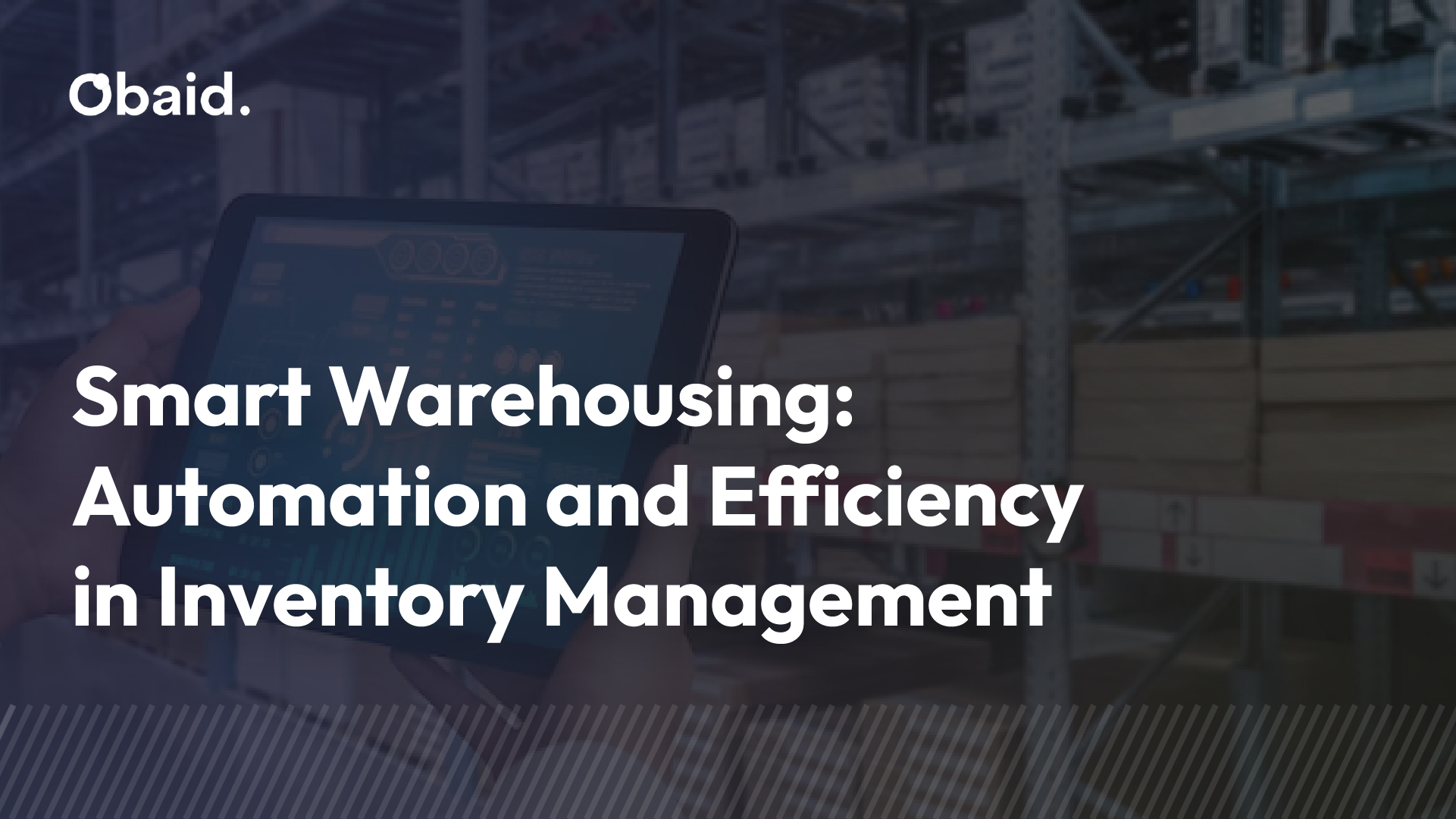Smart Warehousing: Automation and Efficiency in Inventory Management
Published on March 17, 2025

Warehousing is the core of an e-commerce business operation. It’s not where just products are stored but a promise to the customer takes shape. In an industry where 88% of customers are ready to pay an extra amount for faster or same-day delivery, speed and accuracy are non-negotiable to keep customers satisfied. So smart warehousing is a must to optimize space, speed up fulfillment procedures, and minimize mistakes.
Studies show that 43% of small businesses face inventory management challenges, either they are doing everything manually or not tracking inventory at all which is directly impacting order accuracy and customer satisfaction. Furthermore, smart warehousing can reduce operational costs by up to 30%. To keep up with rising demands and expectations, warehousing must be developed into a powerhouse of efficiency and reliability.
What is Smart Warehousing?
Smart warehousing is all about using modern technology to make managing a warehouse easier, faster, and more efficient. Unlike traditional warehouses, where most tasks like tracking inventory or packing orders are done manually, automation in warehousing is made by using tools like robots, sensors, and software to handle these jobs. For example, with smart warehousing, businesses can do real-time inventory tracking using sensors or barcodes, robots can pick up items from shelves, and systems can automatically suggest when to reorder products. This makes operations smooth, reduces mistakes, and saves time.
Why is Smart Warehousing Important for E-Commerce Businesses?
Here’s why it’s needed in e-commerce:
Always Know What’s in Stock
The most frustrating thing for customers is out-of-stock words that their much-needed item is not in stock. This causes nearly 21% of customers to abandon their purchase and go towards your competitors. On the other hand, overstocking is also an issue that adds to storage costs, unnecessary money gets tied up in products that don’t sell, and items may go to waste if they expire or become outdated.
In e-commerce, having real-time inventory visibility is most important. For warehouse optimization, advanced tools like IoT-enabled sensors, RFID tags, and barcode scanners are used to provide accurate, real-time updates on inventory levels. This ensures that businesses always know what’s in stock, where it’s located, and when it needs replenishment.
Faster Deliveries
Online shoppers expect quick shipping. Automation in warehousing speeds up order picking and packing. Systems like robotic pickers and conveyor belts significantly speed up the picking and packing. These technologies reduce the time it takes to locate and prepare products for shipping, often cutting order processing times. This allows businesses to meet the demand for next-day or even same-day delivery, which is a growing expectation in e-commerce.
Fewer Mistakes
The probability of errors in manually handling orders is greater like wrong items can be sent to customers mistakenly. Warehouse automation using robots and software to handle tasks helps to do work with precision, ensuring customers get the right orders.
Cost Savings
Tasks like sorting, picking, packing, and inventory tracking are handled by robots, conveyor belts, and barcode scanners, which significantly reduce the need for human labor. This allows businesses to cut down on staffing costs while maintaining faster and more accurate operations. Research shows warehouse automation can lower labor costs by 20-30%. It minimizes errors, which reduces costs associated with incorrect orders, returns, or damaged goods. Over time, these savings can be reinvested in other areas of the business, like improving customer service or expanding operations.
Handling Big Sales Easily
Handling big sales during peak times, like Black Friday or holiday shopping seasons, can be a challenge for e-commerce businesses due to the surge in orders. Smart warehousing makes this process much easier by using advanced technology to scale up operations quickly and efficiently.
For instance, automated systems like robotic pickers and conveyor belts can handle a high volume of orders at once, ensuring that items are picked, packed, and shipped faster than manual processes. Smart software also helps prioritize and organize orders to prevent confusion or delays, even during the busiest times.
With automated inventory systems, businesses can prepare for big sales events by pre-stocking popular items and optimizing storage layouts for quicker access. This efficiency reduces the risk of late deliveries or stock-outs, keeping customers happy. Companies can maximize their profits and maintain smooth operations, even under high pressure.
Better Use of Space
Traditional warehouses often have unused areas due to improper planning of product placement or the physical limitations of human workers. Smart warehousing systems are designed to maximize storage efficiency, making the best use of available space by incorporating advanced technologies like robotics, automated storage systems, and vertical storage solutions.
For instance, robotic systems can retrieve items from high shelves that are typically out of reach for human workers. This allows warehouses to stack inventory higher, effectively using the vertical space that would otherwise go unused. Automated storage and retrieval systems (AS/RS) are another great example, they can store items in compact spaces and retrieve them with precision, minimizing the need for wide aisles for human access. Optimized storage layout helps locate and ship products faster, ensuring customer satisfaction and reducing operational bottlenecks.
This smarter use of space not only increases the amount of inventory a warehouse can hold but also reduces the need to rent or purchase additional facilities. Warehouses utilizing automation use up to 40% less space as compared to traditional setups. This means businesses can store more products and don’t need to spend extra costs on expanding their storage space to meet growing demand.
Improved Customer Satisfaction
Fast deliveries, accurate orders, and transparency in the shipping process are exactly what today’s online shoppers expect, and meeting these expectations builds loyalty and trust
Environmentally Friendly
Smart systems can also plan the most efficient shipping routes, saving fuel and reducing carbon emissions. They can even minimize waste by optimizing packaging.
Key Technologies Driving Smart Warehousing
Robotics
Automated Guided Vehicles (AGVs) and Autonomous Mobile Robots (AMRs) streamline tasks like picking, sorting, and transporting goods.
Example: Ocado, a UK-based online grocer, uses robots to process 65,000 orders weekly, achieving unmatched speed and efficiency.
Internet of Things (IoT)
IoT-enabled sensors and RFID tags provide real-time data on inventory levels, item locations, and environmental conditions.
Benefits include reduced stock discrepancies and better supply chain visibility.
Artificial Intelligence and Machine Learning
AI optimizes warehouse layouts, predicts demand trends, and automates repetitive tasks.
Example: Amazon’s AI systems predict order patterns, enabling warehouses to pre-package high-demand items.
Big Data and Analytics
Data-driven insights enable smarter decision-making by analyzing order patterns, peak seasons, and inventory turnover.
A survey shows that businesses using analytics in inventory management see a 20-50% improvement in operational efficiency.
Automated Sorting and Conveyor Systems
These systems reduce manual labor by efficiently sorting and moving items within the warehouse.
Example: JD.com, a Chinese e-commerce giant, uses automated sorting systems to handle 200,000 parcels per day.
Benefits of Smart Warehousing for E-Commerce
Increased Efficiency Smart warehouses reduce processing times and operational costs by automating labor-intensive tasks. A study shows that automation in warehousing can reduce operational costs by 30-40%.
Improved Accuracy With technologies like barcode scanning and IoT, smart warehouses achieve inventory accuracy rates of 99.9%, minimizing errors and returns.
Enhanced Scalability Automation allows businesses to scale operations without significant investments in labor, making it easier to manage peak seasons and rapid growth.
Cost Savings By reducing dependency on manual labor and optimizing resource utilization, smart warehouses lower operational costs. For instance, automating picking processes can save businesses up to 70% on labor costs.
Better Customer Experience Faster and more accurate order fulfillment enhances customer satisfaction and loyalty. According to Capgemini, 73% of customers are willing to switch brands for a better delivery experience.
Challenges in Implementing Smart Warehousing
- High Initial Investment
Implementing technologies like robotics and AI requires significant upfront costs, which can be a barrier for small and medium-sized businesses. - Integration Complexities
Integrating smart warehousing solutions with existing systems like ERP or e-commerce platforms can be complex and time-consuming. - Skilled Workforce
Operating and maintaining advanced systems require a skilled workforce, which may involve additional training costs. - Cybersecurity Risks
IoT-enabled devices and connected systems are vulnerable to cyberattacks, necessitating robust security measures.
Real-World Success Stories
Amazon
Amazon’s smart warehouses use robotics, AI, and IoT to handle millions of orders daily. Their system has reduced warehouse operating costs by 20% while significantly increasing order fulfillment speed.
Zara
Zara’s automated warehouses streamline inventory management across online and offline channels. This omnichannel approach has improved delivery times and reduced overstock situations.
Alibaba’s smart warehouse in China employs robots that handle 70% of the work, enabling the company to process 1 billion orders during Single’s Day 2021.
Future of Smart Warehousing in E-Commerce
The future of e-commerce relies heavily on smart warehousing. Emerging technologies like drones for last-mile delivery and 5G for faster data transmission will further revolutionize this space. According to forecasts, the global warehouse automation market is expected to reach $30 billion by 2030, reflecting the growing importance of smart warehousing.
Steps to Implement Smart Warehousing
- Assess Business Needs Evaluate your order volume, inventory complexity, and operational challenges to determine the right level of automation.
- Invest in Scalable Solutions Choose technologies that can grow with your business, ensuring long-term cost-effectiveness.
- Train Your Workforce Provide training to employees on operating and maintaining automated systems.
- Focus on Integration Ensure seamless integration between smart warehousing tools and your existing ERP or e-commerce platform.
- Monitor and Optimize Regularly analyze data from your smart warehouse to identify areas for improvement and refine your processes.
Conclusion
Smart warehousing is no longer a luxury but a necessity for e-commerce businesses aiming to stay competitive in today’s fast-paced market. By leveraging automation and advanced technologies, businesses can achieve greater efficiency, accuracy, and customer satisfaction. While challenges like high costs and integration complexities exist, the long-term benefits far outweigh these hurdles. As e-commerce continues to evolve, smart warehousing will play a crucial role in shaping its future, driving growth, and delivering exceptional customer experiences.

Obaid Arshad
CEO & Co-Founder
